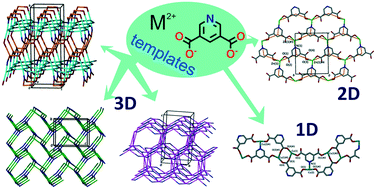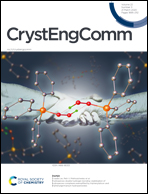New metal–organic frameworks derived from pyridine-3,5-dicarboxylic acid: structural diversity arising from the addition of templates into the reaction systems†
Abstract
A series of new compounds prepared from reactions of pyridine-3,5-dicarboxylic acid (PDCH2), bipositive d-metal ions (Cd2+, Zn2+, Co2+ and Cu2+) and various template molecules [1,3-propanediol (pdH2), diethanolamine (deaH3), N-phenyldiethanolamine (phdeaH2), triethanolamine (teoaH3), 2-hydroxymethylpyridine (2hmpH), 3-hydroxymethylpyridine (3hmpH), 3-hydroxypropylpyridine (3hppH), and 4-hydroxymethylpyridine (4hmpH)] are reported. Among them, [[(CH3)2NH2]2[Cd2(PDC)3]]n·4nDMF·6nH2O, [1], [Mn(PDC)(DMF)]n, [2], [Mn3(PDC)2(INA)2(DMF)1.5(H2O)0.5]n·nDMF·2nH2O, [3], and [Zn(PDC)(NMP)]n·nH2O, [4], are 3D coordination polymers, [Zn(PDC)(H2O)(DMF)]n, [5], [Zn(PDC)(3hmpH)]n·nDMF·0.5nH2O, [6], and [Co(PDC)(3hmpH)2]n·0.25nDMF, [8], have 2D polymeric structures, while [Zn(PDC)(2hmpH)2]2·2DMF, [7], is a 0D binuclear complex, and [Cu(PDC)(3hmpH)2]n·0.5nDMF·1.5nH2O, [9], is a chain polymer. Topological analysis reveals that some of the compounds display unusual structural architectures and two of them, in particular [1] and [3], present new topological types. The effect of the use of amino alcohol/polyol templates on the formation of the new compounds is also discussed in detail. The thermal stability of the prepared complexes was also studied. This study represents the initial systematic investigation on the use of a combination of polytopic nitrogen and oxygen-donor ligands and amino- or pyridine-alcohol templates for the synthesis of new MOFs.



 Please wait while we load your content...
Please wait while we load your content...